Попри шок, біль, тисячі загиблих та безпрецедентні руйнування, перший рік повномасштабної війни минув для українців із впевненістю у перемозі та сподіваннями на швидкий наступ у 2023 році. Ці сподівання не справдилися.
І попри те, що цивільні стали гинути рідше, кількість російських атак і руйнувань зменшилася, у другій половині року прийшло розуміння, що війна – це не лише про території, але й про витривалість.
В такій війні те, що відбувається в економіці, – скільки вона продукує доходів, які видатки вони можуть покрити, скількома мільярдами можуть допомогти союзники – є не менш важливим, ніж те, що відбувається на фронті.
Ми зібрали головні цифри про те, як Україна пережила другий рік війни.
Деякі з них також вказують, в якому напрямку можуть розвиватися події у 2024 році.
Загиблі
Впродовж другого року великої війни кількість загиблих та поранених серед цивільних зменшилася.
За даними Офісу генерального прокурора (ОГПУ), загалом від початку російського вторгнення і до кінця 2023 року загинули 11673 людини. Із них за 2023 рік – 2821. Тобто втрати серед цивільних за другий рік війни становлять близько чверті від втрат впродовж всіх двох років великої війни.
Крім того, за даними ОГПУ, за час російського вторгнення до початку 2024 року поранення отримали 18336 українців. Третина цієї цифри – 6403 – припадає на 2023 рік.
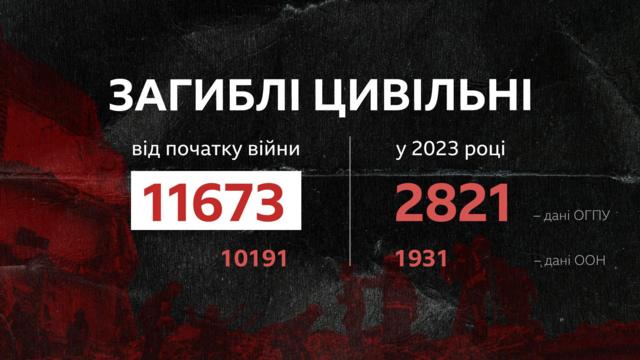
Водночас за підрахунками Управління Верховного комісара з прав людини (УВКПЛ) ООН, яке документує втрати серед цивільних в Україні з 2014 року, цифри загиблих є дещо меншими. За підрахунками ООН, від початку великої війни в Україні до початку 2024 року загинули 10191 цивільних, 8260 смертей припадають на 2022 рік, та 1931 смертей – на 2023.
Втім, там наголошують, що “реальна кількість може бути більшою, оскільки деякі звіти ще очікують на підтвердження”. А отже, кількість смертей у 2023 році, очевидно, може зрости через велику кількість загиблих в останні дні 2023 року – на початку 2024, коли, за попередніми даними ООН, загинули 90 людей.
Крім того, все ще неможливо точно встановити, скільки людей загинули у перший рік війни в Маріуполі, Лисичанську, Попасній та Северодонецьку, де повідомляли про великі жертви серед цивільних, але доступу до цих територій немає через російську окупацію.
На початку 2024 року правозахисна організація Human Rights Watch оцінила кількість загиблих під час боїв цивільних в Маріуполі щонайменше у 8 тисяч. Тож очевидно, що з часом загиблих цивільних може виявитися на порядок більшою.
Як і у 2022 році, впродовж другого року війни офіційні особи не називали жодних конкретних цифр щодо втрат ЗСУ. Але і президент, і представники його офісу неодноразово говорили про 30-50 загиблих воїнів щодня.
У січні 2024 року очільник парламентської фракції “Слуга народу” Давид Арахамія заявив, що звернувся до президента Зеленського з пропозицією розсекретити дані стосовно втрат України у війні. За словами депутата, президент ще не ухвалив остаточного рішення.
Але, як каже Давид Арахамія, кількість загиблих українських військових є “набагато меншою”, ніж 100 тисяч.
Пізніше в інтерв’ю американському телеканалу Fox News президент Зеленський заявив:
“Якщо порівнювати кількість загиблих військових, то Росія втрачає п’ять солдатів на кожного вбитого українського захисника”.
При цьому він нагадав, що, за даними українського Міноборони, росіяни втратили понад 400 тисяч вояків.

Наприкінці 2022 року в Офісі президента заявляли про 10-13 тисяч вбитих.
Через рік, наприкінці 2023 року, світова преса наводила на порядок вищі цифри. Зокрема, французька Liberation написала про 200 тисяч загиблих і поранених, американський часопис Time писав про 100 тисяч загиблих з українського боку, а британський Economist у листопаді – про 70 тисяч загиблих.
За підрахунками сайту “Книга пам’яті полеглих за Україну”, загальна кількість загиблих або померлих воїнів від початку російського вторгнення становить понад 30 тисяч. Цю інформацію зібрали станом на середину листопада 2023 року, і вона лягла в основу створення Стіни пам’яті полеглих у 2014-2021 роках у Михайлівському золотоверхому соборі в Києві.
Були й спроби підрахувати кількість загиблих за оприлюдненими указами президента про нагородження військовослужбовців посмертно.
Журналісти підрахували, що до середини жовтня 2023 у таких указах згадується 14402 воїни. Проте є ще й закриті укази про нагородження посмертно, якщо вони стосуються працівників СБУ, ГУР та інших спецпідрозділів.
Після свого призначення Головнокомандувачем на початку лютого 2024 року Олександр Сирський в інтерв’ю німецькому ZDF заявив, що російські втрати, особливо загиблими, “в 7-8 разів, за останніми даними, переважають наші втрати”.
Витрати на війну
Видатки на безпеку та оборону фінансуються виключно коштом доходів від податків та інших платежів, що надходять до бюджету з української економіки. Нині фактично всі вони ідуть на фінансування цієї статті, яка “важить” половину бюджету.
За інформацією міністерства фінансів, видатки на безпеку та оборону у 2023 році становили 2,6 трлн грн, або понад 40% від очікуваного ВВП країни (остаточні дані щодо цього будуть відомі пізніше). Це на понад трильйон гривень або на 72% більше, ніж у 2022 році.
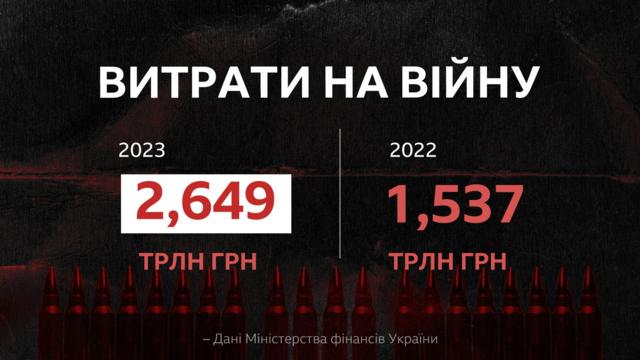
За підрахунками економістів, видатки лише на армію в Україні перевищують третину ВВП.
Для порівняння: у країнах НАТО, які мають набагато міцніші економіки, ніж в України, у мирний час ця цифра становить до 2%.
Міжнародна допомога
Покривати іншу половину видатків бюджету – зарплати держслужбовцям, бюджетникам, соціальні виплати – вдавалося завдяки фінансовій допомозі міжнародних партнерів України.
Весь 2023 рік вона надходила ритмічно і у великих обсягах. Загалом, за даним міністерства фінансів, Україна отримала 42,5 млрд доларів зовнішнього фінансування. Понад чверть цієї суми були грантами, тобто ці гроші не потрібно буде повертати.
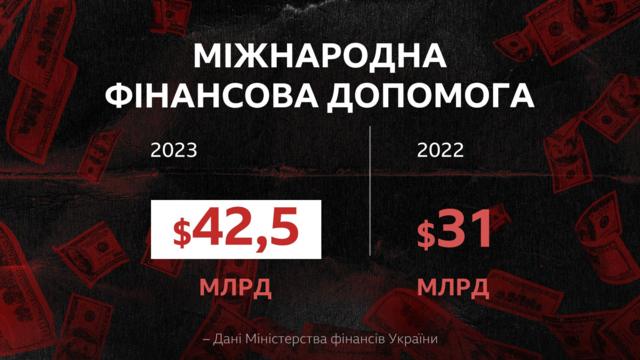
Головним “спонсором” України у 2023 році став Європейський Союз, від якого надійшло понад 19,5 млрд доларів. Від США, які вели перед за обсягами допомоги у 2022, надійшло майже вдвічі менше – 10,95 млрд доларів.
Іншими великими донорами фінансової допомоги Україні були МВФ (4,475 млрд доларів), Японія (3,626 млрд доларів), Канада (1,757 млрд доларів), Велика Британія (998 млн доларів) та Світовий банк (660 млн доларів).
Водночас якщо “зважити” допомогу на розмір економік країн-союзниць України, то, за даними Ukraine Support Tracker, найбільшу підтримку надають скандинавські та балтійські країни: Естонія, Данія, Норвегія, Литва та Латвія.
Зовнішнє фінансування, отримане Україною у 2023 році, перевищило і обсяги 2022 року, і очікування українського уряду.
Але, очевидно, 2023 рік так і залишиться рекордом. Убюджеті на 2024 рік спочатку записали план отримати 41 млрд доларів від міжнародних партнерів, але згодом мінфін урізав цю потребу до 37,3 млрд доларів.
Руйнування та збитки
За підрахунками Київської школи економіки (KSE), яка від початку російського вторгнення веде облік економічних втрат України, станом на січень 2024 року загальна сума прямих збитків, завдана інфраструктурі України, зросла до 155 млрд доларів.
На січень 2023 ці втрати оцінювали у 138 млрд доларів.
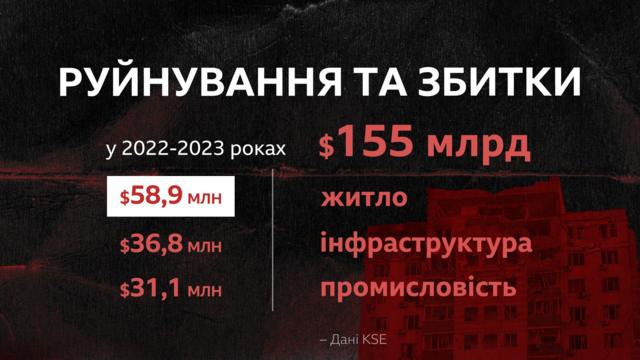
На початок 2024 року у загальному обсязі прямих збитків найбільшою часткою залишаються втрати житлового фонду — 58,9 млрд доларів. І тут зростання збитків є найбільшим порівняно із першим роком війни.
Серед регіонів, які найбільше постраждали від руйнування житла, — Донецька, Київська, Луганська, Харківська, Миколаївська, Чернігівська, Херсонська та Запорізька області.
На другому та третьому місці за сумою збитків залишається інфраструктура та промисловість й втрати підприємств —36,8 млрд та 13,1 млрд доларів відповідно.
У KSE також підрахували, що внаслідок підриву Каховської ГЕС 6 червня 2023 року лише у чотирьох населених пунктах лівобережної Херсонщини постраждало – були повністю або частково затоплені – щонайменше 19 тисяч будинків.
Біженці за кордоном
За даними Управління Верховного комісара ООН з питань біженців (УВКБ ООН), на середину лютого 2024 року за кордонами України перебувало 6,479 млн біженців. Левова частка з них – понад 6 млн – перебувають у Європі, при цьому тимчасовий захист там отримали 5,809 млн українців.
Якщо порівнювати ці цифри із першим роком війни, то загальна кількість українців у Європі стала трохи меншою, тоді як кількість зареєстрованих в системі тимчасового захисту, що дає право на роботу та соціальні виплати, зросла.

За опитуванням, проведеним УВКБ ООН, 80% біженців з України – жінки, у 69% з них в Україні залишився хтось із родини. Середній вік біженців з України становить 44 роки.
Найбільше українських біженців на початок лютого 2024 року року зафіксовано в Німеччині – 1,140 млн людей, із яких понад мільйон отримали тимчасовий захист.
У Польщі, яка вела перед за кількістю біженців з України у 2022-му, тепер перебувають 956 тисяч українців. Проте загалом за час війни тимчасовий захист у Польщі отримали понад 1,6 млн українців.
У Росії та Білорусі, за оцінками ООН, перебувають близько 1,252 млн українців.
Переселенці в Україні
За даними уряду, в Україні майже п’ять млн внутрішньо переміщених осіб. Із них 3,6 млн залишили домівки після початку повномасштабного російського вторгнення, заявила віцепрем’єрка, міністр з питань реінтеграції тимчасово окупованих територій Ірина Верещук.
Понад половина ВПО отримують щомісячні виплати.
За даними міністерства фінансів, у 2023 році на виплати ВПО з бюджету пішло понад 73 млрд грн. Це удвічі більше, ніж, наприклад, на покриття усіх комунальних субсидій в країні.
Водночас, за даними Мінсоцполітики, 158 тисяч людей втратили право на виплати, оскільки виїхали за кордон.
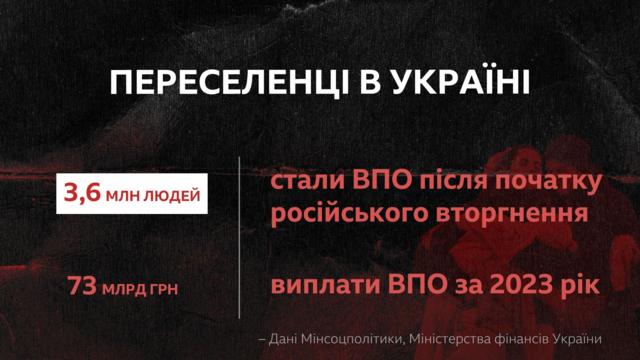
За даними Міжнародної організації міграції (МОМ), кількість внутрішніх переселенців в Україні на кінець 2023 року становила 3,689 млн людей. Із них майже половина походить із двох областей – Харківської та Донецької.
І так само близько половини переселенців знайшли притулок у двох, фактично, прифронтових областях – Харківській та Дніпропетровській (трохи менше пів мільйона в кожній). Крім того, великим осередком розселення ВПО є Київ та Київська область.
Головна причина “популярності” цих регіонів, припускають у МОМ, – це можливість знайти роботу. У західних регіонах, де навесні 2022 перебувала понад третина внутрішніх переселенців, до весни-2023 залишилися лише 16%.
Кожним двом із п’яти переселенців довелося переїжджати не один раз, – у МОМ відзначають, що це пов’язано із неможливістю знайти роботу там, куди переїздять люди. Чоловіки частіше за жінок кажуть, що не можуть знайти роботу після переселення. Кожен десятий переїжджав понад три рази.
За оцінками МОМ, близько 4,5 млн людей повернулися до звичного місця проживання після певного періоду переміщення – по Україні чи за кордоном. При цьому 319 тисяч тих, повернувся з-за кордону, стали переселенцями в Україні.
Найбільше поверталися з Угорщини, Польщі та Румунії.
Лише 37% із тих, хто повернувся з-за кордону, отримують регулярну зарплату. Решта живуть на пенсії та соцвиплати для ВПО.
На відміну від біженців за кордоном, частка жінок серед ВПО є нижчою – близько 60%, і значно вищою є частка літніх людей – серед переселенців їх майже чверть. Серед ВПО також більшою є частка людей, які кажуть, що за час війни вичерпали всі свої заощадження.
Зростання економіки?
Після падіння майже на третину за 2022 рік, з другого кварталу 2023 року український ВВП вийшов у “плюс”.
За різними оцінками, зростання за другий рік війни може становити 5-5,5%. Остаточні дані щодо динаміки ВВП у 2023 році стануть відомі пізніше.
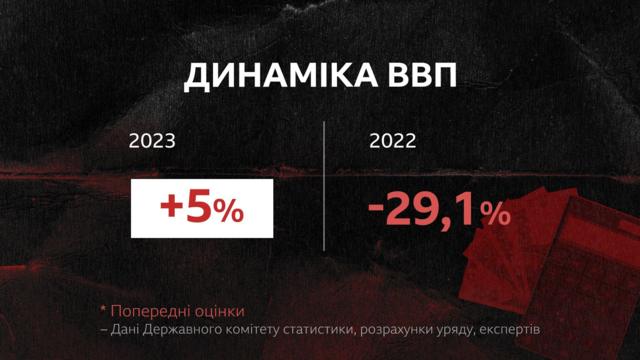
Насамперед, це пояснюється низькою базою порівняння – падіння економіки у перший рік війни було таким глибоким, що на цьому тлі навіть просте припинення падіння виглядатиме як зростання. Врешті, попри відновлення росту, український ВВП приблизно на чверть менший, ніж у довоєнному 2021.
З іншого боку, українська економіка явно оговталася від перших шоків, пов’язаних із початком російського вторгнення. А деякі економічні показники виявилися кращими за прогнози.
Втім, ефект низької бази порівняння вже вичерпав себе, і надалі відновлення йтиме повільніше. Це підтверджують попередні дані за січень 2024, коли, за підрахунками Мінекономіки, ВВП України зріс лише на 3,5% порівняно із січнем 2023-го.
Гривня, інфляція, ціни
Серед показників, які повелися краще, ніж від них очікували, – курс гривні. Національна валюта країни, яка другий рік поспіль веде повномасштабну війну, більшу частину року навіть зміцнювалася.
При тому, що уряд закладав у бюджет 2023 року середньорічний курс 42,2 грн за долар, реальний середньорічний курс був нижчим і від урядових, і від неурядових прогнозів.
Врешті, НБУ навіть вирішив відмовитися від жорсткої фіксації офіційного курсу гривні до долара, запровадженого з перших днів війни, і перейшов до “керованої гнучкості”, підтримуючи гривню валютними інтервенціями з резервів.
Але наприкінці 2023 гривня почала “просідати”. І у 2024 рік увійшла з офіційним курсом у 38 грн за долар.
Весь другий рік війни так само позитивними були й новини щодо інфляції, ще одного показника зі сфери компетенції Нацбанку. Якщо 2022 рік Україна завершила зі зростанням цін у понад 26%, то 2023-й завершувала із показником, якого не давалося досягти навіть за мирних часів, – близько 5%.

У самому Нацбанку пов’язують ці два показники так: зняти інфляційний тиск дозволила валютна стабільність. Серед інших факторів там називають гарний врожай, що сприяв зниженню цін на харчі, а також замороження комунальних тарифів.
Оглядачі ж серед головних причин курсової та цінової стабільності називають відмову від фінансування дефіциту держбюджету за рахунок “друку” грошей. А це, своєю чергою, стало можливим через масштабну допомогу міжнародних партнерів, завдяки якій валютні резерви НБУ у 2023 році сягнули 40,5 млрд доларів, перевищивши попередній рекорд 2011 року у 38,4 млрд доларів.
Виглядає, що чим більше проблем буде із залученням міжнародної допомоги в майбутньому, тим важче буде втримати під контролем зростання цін та курс гривні.
Від експорту до імпорту
До війни українська економіка була значною мірою орієнтованою на експорт. У 2021 році саме він формував близько 40% українського ВВП і становив понад 68 млрд доларів.
Але на другому році війни доходи від нього зменшилися до 36 млрд доларів. У 2022 році Україна змогла експортувати на 44,2 млрд доларів.
Крім того, на другому році війни імпорт до України фактично удвічі перевищив експорт. За даними Державної митної служби, у 2023 році Україна імпортувала товарів на 63,5 млрд доларів. А дефіцит зовнішньої торгівлі (перевищення імпорту над експортом) навіть порівняно із 2022 роком, за підрахунками НБУ, зріс у понад два рази.
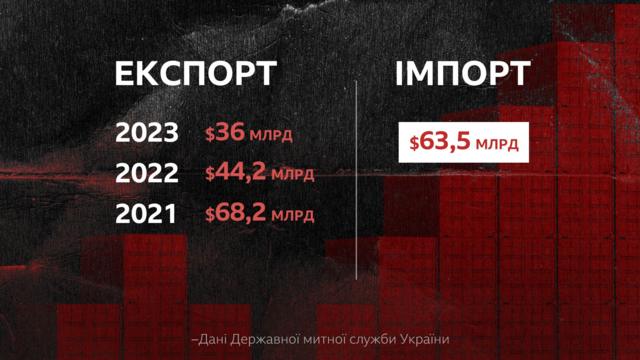
До цього призвели втрати підприємств на окупованих росіянами територіях (переважно металургійні), а також системні проблеми на усіх експортних шляхах – від Чорного моря до західних кордонів на суходолі з європейськими країнами, де мали б працювати “коридори солідарності”.
Російська блокада українських портів у Чорному морі та вихід Росії із морського зернового коридору змусили Україну переорієнтовувати експорт на Дунайські порти. А також опановувати і відстоювати свій власний коридор у Чорному морі, спираючись на захист ЗСУ товарних суден.
Під кінець 2023 року морський експорт зернових фактично дозволяв експортувати стільки ж, скільки на піку можливостей зернового коридору за участі Росії та посередництва ООН і Туреччини у 2022-му.
Крім того, цим шляхом на експорт стала надходити й продукція металургії. Це, у свою чергу, дозволило збільшити завантаженість металургійних підприємств, які стали виходити на 70% своєї довоєнної потужності.
Західний кордон – передусім із Польщею, від травня-2023 працював зі значними обмеженнями, а то й взагалі був закритий для українських товарів та перевезень через протести – спочатку фермерів, потім перевізників, які вважають, що присутність українських товарів та послуг руйнує їхні внутрішні ринки.
Попри все це Польща присутня у трійці лідерів за обсягами і українського експорту, і імпорту.
Загалом Україна найбільше експортувала до:
- Польщі — на 4,7 млрд доларів;
- Румунії — на 3,7 млрд доларів;
- Китаю — на 2,4 млрд доларів.
При цьому найбільше доходів – із великим відривом від усіх інших статей – Україні приніс експорт аграрної продукції – майже на 22 млрд доларів.
Експорт металів дав у понад п’ять разів менше – майже 4 млрд доларів.
Водночас вперше за роки існування галузі експорт послуг ІТ з України скоротився – до 6,7 млрд доларів. Це на понад 600 млн доларів менше ніж за 2022 рік.
Не на тому шляху?
Порівняно із першим роком війни українці стали значно менше довіряти владі, а довіра до органів правопорядку та правосуддя ще більше впала. Проте є й інституції та люди, яким більшість українців й надалі довіряють.
За даними опитування Київського міжнародного інституту соціології (КМІС), проведеного наприкінці листопада-початку грудня 2023, українці найбільше вірили ЗСУ (96%), і ця довіра не змінилася впродовж ще одного року війни.
Так само сталою та високою довірою українців користуються волонтери (84%).
Січневе опитування Центру Разумкова має схожі результати: ЗСУ довіряють 95% українців, а волонтерам – 78%. Серед лідерів довіри також добровольчі загони, ДСНС, Нацгварідя, прикордонники та СБУ.
Президенту Володимиру Зеленському все ще довіряють більшість українців, але їх стало значно менше. За даними Центру Разумкова, самому інституту президента довіряють 64%, тоді як персонально у Володимира Зеленського довіра на рівні 69%.
Водночас за опитуванням КМІС, на початку лютого 2024 року Володимиру Зеленському довіряли 65% опитаних. А відставка Головнокомандувача Валерія Залужного “коштувала” президенту ще 5% рейтингу довіри.
При цьому відставленому генералу у лютому 2024 довіряли 94% українців. Його наступнику на посаді Головнокомандувача Олександру Сирському довіряють 40%.
До війни, за даними КМІС, президенту Зеленському довіряли 37% українців, але у перші місяці війни цей показник підстрибнув до 90%. Після цього підтримка почала падати, – у грудні 2022 голові держави довіряли 84%, а наприкінці 2023 – вже 77%.
Інші органи центральної влади мають значно меншу довіру, і вона знижується. За даними КМІС впродовж року кількість тих, хто довіряє уряду та Верховній Раді скоротилася удвічі.
За опитуванням Центру Разумкова, Кабмін та Верховна Рада – серед лідерів недовіри. Уряду не довіряють кожні троє із п’яти опитаних.
“Наростання критики і зниження довіри владі, скоріше за все, є наслідком, з одного боку, несправджених очікувань на цей рік та, з іншого боку, претензіями щодо ефективності та прозорості діяльності”, – вважають соціологи.
Загалом, за даними КМІС, в Україні дедалі меншає тих, хто вважає, що справи в країні розвиваються у правильному напрямку.
При цьому суттєві зміни відбулися на зламі 2023 та 2024 року, коли вперше від початку війни тих, хто вважає, що країна іде хибним напрямком, стало більше. Якщо після перших місяців війни тих, хто казав про правильний напрямок, було 68%, то до грудня 2023 їхня кількість скоротилася до 54%, а ще за два місяці – до 44%.

Досить схожі результати має і Центр Разумкова. За опитуванням центру, якщо до війни, у грудні 2021-го у правильному напрямку руху України були впевнені лише 20% населення, то після початку війни до осені 2022-го у правильності шляху були переконані понад половина українців.
Максимуму цей показник досяг у лютому-березні 2023 – 61%. Після цього впевненість знижувалася, і у січні 2024 знизилася до 41%.
Найчастіше, за даними Центру Разумкова, українці критикують такі сфери:
- рівень цін і тарифів (на погіршення ситуації вказали 86%),
- економічне становище країни (68%),
- рівень стабільності (64,5%),
- упевненість громадян у завтрашньому дні (63,5%),
- рівень добробуту їхньої родини (58%),
- ставлення громадян до влади (53%).
Водночас є і сфери, про які українці відгукуються позитивно. Це ліквідація наслідків масованих обстрілів енергетичної інфраструктури, а також стала робота комунальних служб і торгівлі, забезпечення харчами.
Позитивні ж зміни останнього року, на думку українців, найбільшою мірою стосуються обороноздатності та міжнародного іміджу України.

